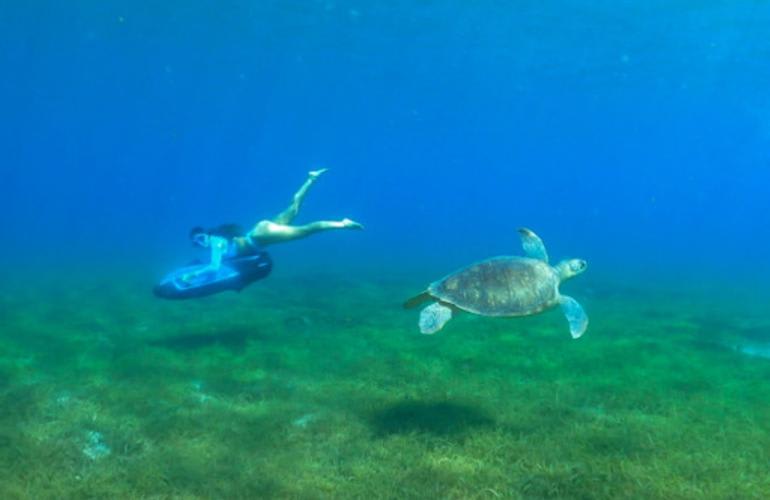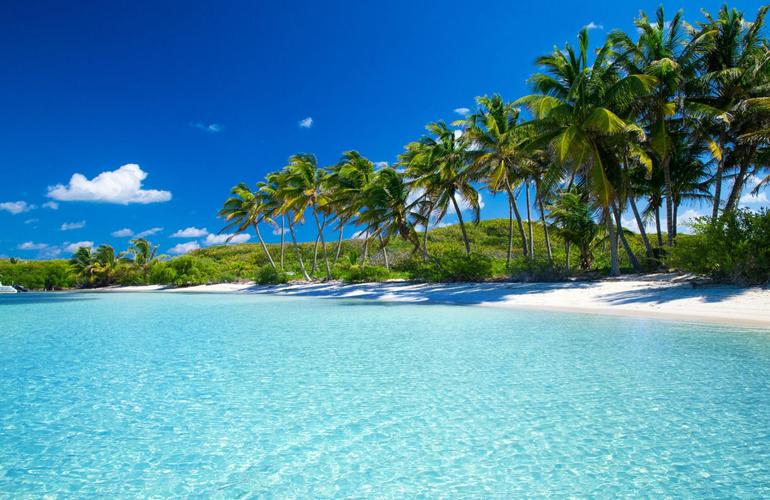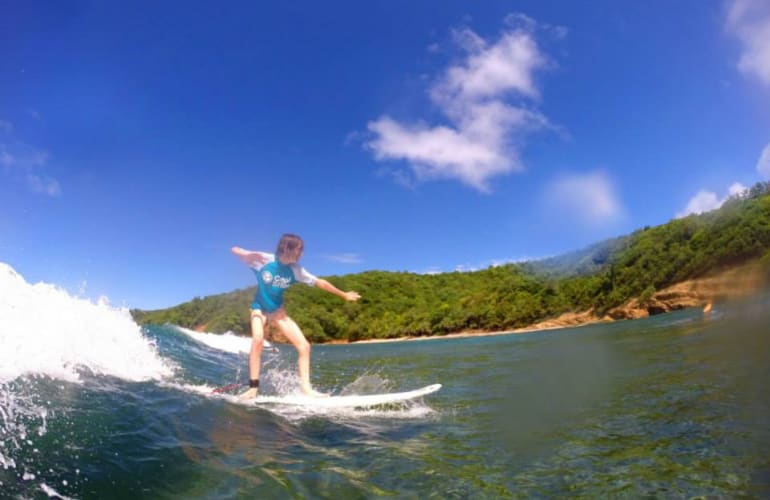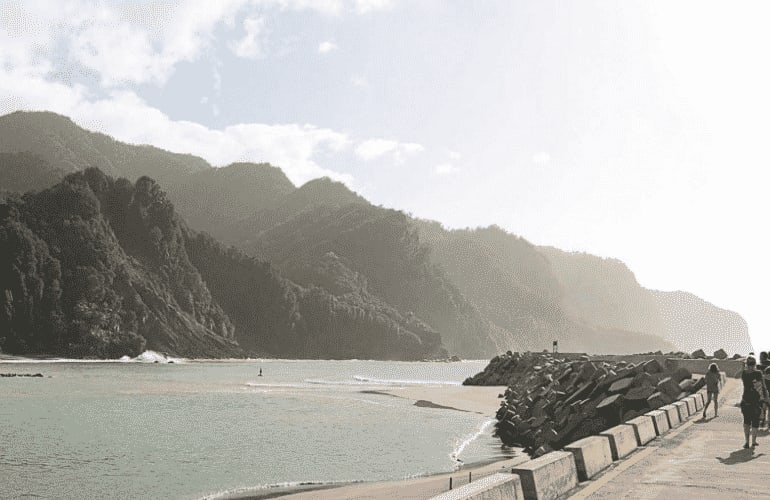Itinerary of things to do in Martinique

Nestling between the Caribbean Sea and the Atlantic Ocean, the island of Martinique and its picture-postcard landscapes are a dream come true for anyone looking for heavenly beaches and tropical flora. What's more, thanks to the many activities on offer in Martinique, the island is perfect for nature lovers and adventurers. Known as the "island of flowers", Martinique is part of the volcanic arc of the Lesser Antilles archipelago, between Dominica to the north and Saint Lucia to the south. It has been designated a UNESCO Biosphere Reserve since 2021 for its entire land and sea territory. Like other overseas islands, it is divided into four arrondissements: Saint-Pierre in the north-west, La Trinité in the north-east, Fort-de-France in the centre and Le Marin in the south.
Although Martinique is a fairly small island, 60 km long and 30 km wide, there are plenty of things to do in the island, and this article will prove it! So if you're planning a trip there soon, check out the best things to do in Martinique here!
The south of Martinique, a beach paradise
Freshly landed at Martinique's international airport, in the commune of Le Lamentin, after an eight-hour flight from Paris, all you'll want to do is relax on the paradisiacal beaches of the south of the island. And that, of course, is THE thing to do in Martinique. So let's start this journey of things to do in Martinique in the south, in the arrondissement of Le Marin, the most touristy area of the island.
Creole cuisine and water sports in Anses-d'Arlet

Anyone travelling to Martinique will want to come back with a photo of the village of Anses-d'Arlet and its church from the end of its pontoon bridge, overlooking the turquoise waters at the edge of its beach. Les Anses-d'Arlet is a commune with a charming village on the edge of the Caribbean Sea, a perfect way to start your trip to Martinique. It's also an opportunity to discover the island's culinary culture thanks to the many local restaurants here, one of the most important things to do on a trip being of course to sample the specialities of the region you're visiting! Get your taste buds ready and sample some of Martinique's Creole dishes:
- As a starter, start with cod, prawn or vegetable accras to whet your appetite, or try the féroce, made with avocado flesh, de-salted cod, manioc flour and chilli pepper, a big name in Martinique gastronomy!
- For the main course, there are plenty of spicy recipes to tempt you, but it's essential to try some seafood (lambi, for example, a mollusc made from conch shells), as well as smoked chicken, a must if you like street food!
- And for dessert, try a cinnamon apple, an island fruit that lives up to its name; a banana gratin, a very interesting sweet and savoury combination; or quite simply a pain au beurre chocolat that will remind you of French pastries.

Once your belly is full, you'll have enough energy to take part in all sorts of water-based activities available in Anses-d'Arlet: wakeboarding, water-skiing, paddle boarding, diving and boat trips to meet Caribbean dolphins - you won't have time to get bored! The Anses-d'Arlet commune also offers some incredible spots for snorkelling with sea turtles, including Anse Dufour, a magnificent white sand beach, and a few minutes' walk further on Anse Noire, the only black sand beach in the south of Martinique, with a wild appearance reminiscent of the beaches in the north of the island.
Introduction to the history of Martinique in Trois-Îlets

Les Trois-Îlets is one of the most popular tourist destinations in Martinique, and for good reason: its coastline is lined with beaches facing the Bay of Fort-de-France, making it the perfect base for a host of water sports activities in Les Trois-Îlets, particularly at the Pointe du Bout and its beautiful Anse Mitan beach: kitesurfing, diving, jet ski tours, etc., and even parasailing!
This is also where you'll find the pottery village, worth a visit for its Creole houses and old pottery workshops. One of the things to do in Martinique is also to take an interest in its history. Les Trois-Îlets is home to the Savane des Esclaves, a must-see open-air museum in Martinique, surrounded by nature that you can enjoy on quad bikes, buggies, horses and even motocross bikes!
One of the symbols of Martinique: the Diamond Rock

It's unthinkable to travel to Martinique without considering a visit to the famous Rocher du Diamant, renowned for being an incredible diving site, but also for offering a superb spectacle at sunset. Whether from Morne Larcher or Le Diamant beach, admiring its walls sparkle at certain times of day depending on the light is one of the things to do in Martinique.
Also, on your way along the Diamant coast is the Cap 110 memorial, where 15 statues stand in commemoration of the sinking of a slave ship in 1830. It's an impressive monument to see, with the Maison du Bagnard, a small, colourful building not far away that's also worth a photo. Discover this coastline on a jet ski trip to the Rocher du Diamant.
Tour of Sainte-Anne, the southernmost tip of Martinique
If you've ever looked for the most beautiful beach in Martinique, you're bound to have seen the name of the commune of Sainte-Anne come up: in fact, this is where you'll find Plage des Salines, a long, splendid beach of white sand fringed with coconut palms. A real picture-postcard landscape, as is the pond just behind it, a paradise for Martinique's birds. And that's not all: Sainte-Anne also has other beaches, each just as beautiful as the next, including Anse Trabaud facing the Atlantic Ocean, and Anse Michel a little further north, facing the superb islet of Chevalier. What about exploring the coast and admiring the magnificent beaches on a jet ski tour from Sainte-Luce?

If you fancy a change from fare niente and bathing by the beach, you can hike around the îlet Chevalier, or follow the Atlantic coast of Sainte-Anne to the Oeil Bleu at Cap Ferré, a natural pool of mesmerising turquoise blue, but where swimming is dangerous due to the unpredictable swell of the ocean. And if you're not afraid of the heat, take a tour of the Savane des Pétrifications, the hottest spot on the island because it's desert.
Other not-to-be-missed activities in the south of Martinique
As well as the communes of Anses-d'Arlet, Trois-Îlets, Diamant and Sainte-Anne, you're also sure to spend some time in Sainte-Luce, mentioned above. This spot is popular for its beaches and the water activities it offers, including jet skiing for those in search of adrenaline. Another point of interest for hiking in the Le Marin arrondissement is Trou-Cochon, on the Vauclin peninsula on the Atlantic Ocean side, renowned for the mangrove swamp that thrives in several places in Martinique. And if you're interested in Martinique's flora, don't hesitate to visit the Jardin de la Montagne, in the commune of Le Vauclin.
The southern region of the island of Martinique is packed with things to do both on the coast and inland, offering the many activities we've just looked at in its most popular communes. This is definitely THE region of Martinique not to be missed, whether you're looking for adventure or just a relaxing holiday.
The centre of Martinique, a hive of activity
Let's head back to Le Lamantin and its international airport, your point of arrival on the island. Apart from the south and its tourist activity, it's in the central region of Martinique that you'll find the most activity: this is where the capital, Fort-de-France, is located.
Things to see in Fort-de-France, capital of Martinique

Just ten minutes from Martinique Aimé Césaire international airport, Fort-de-France is often the city that tourists choose to visit first on their arrival in Martinique. Its monuments and bustle provide an introduction to Martinique's culture and history. This is where you can see just how colourful Martinique's culture is: the colour of the buildings, the clothes, but also the local produce on display in the stalls of Fort-de-France's famous covered market. You'll be enchanted by the warmth of the local population!
Whether it's a day trip or more, there's plenty to do in Fort-de-France: between visits to Saint-Louis cathedral, the Schoelcher library, Saint-Louis fort with its iguanas and many others, as well as shopping for souvenirs and typical Martinique products, you won't have time to get bored!
Discover rum and its history in Le François
A land of sugar cane cultivation, Martinique is also a producer of rum, and boasts a number of distilleries. The most famous of these, and the most visited, is the Habitation Clément in Le François, an estate in the heart of the sugar cane plantations that has been transformed into a museum where you can discover the history of this old rum distillery, which is a must-see in Martinique.

As well as the Habitation Clément, Le François is also popular for its access to the Baignoire de Joséphine, a swimming area on white sandy shallows between the islets Oscar and Thierry in the Atlantic Ocean. You can get there on a catamaran excursion, or by transparent kayak, a unique way to cruise the turquoise waters of the Baignoire de Joséphine!
Wilderness walks on the Caravelle peninsula
Still on the Atlantic side, a little further north of Le François lies the Presqu'île de la Caravelle, a must-visit spot in Martinique. Declared Martinique's National Nature Reserve in 1975, it's a superb place to admire the ocean waves crashing against its cliffs and to discover Martinique's flora, including the famous mangroves.

Another thing to do on the Presqu'île de la Caravelle is to pass by Tartane beach and its fishing village before visiting the Château Dubuc, located just before the Caravelle lighthouse. Before returning to the commune of La Trinité, where you can continue your hike to see the curiosity of the Pink Mangrove of Trinité, don't hesitate to take a surfing lesson on the Presqu'île de la Caravelle!
Sports activities around the Pitons du Carbet mountain range
To the east of Martinique, above Fort-de-France and the commune of Saint-Joseph, lie the Pitons du Carbet. There are 5 of them, the highest reaching an altitude of 1196 m, and they are packed with hiking trails accessible to all levels. This mountain range is also a great place for canyoning in Martinique, whether it's a descent into the canyons of the Mitan river, the Piton de l'Alma, the Absalon or others, and discovering beautiful waterfalls, including the most famous on the island of Martinique: those of Didier and Saut du Gendarme.

You'll also find the famous Jardin de Balata not far away, which is definitely a must-visit in Martinique. It's a great way to learn more about the island's flora and fauna, with the garden boasting many species of tropical plants, while enjoying a pleasant stroll along high bridges suspended 15 m between the garden's tallest trees. Just the thing to relax after all that hiking and canyoning!
The centre of the island of Martinique has fewer heavenly beaches than the south, but just as many things to do! It's a part of the island not to be overlooked on your trip, and one to which you can devote a few days, one of which will be spent exploring Fort-de-France and its lively streets, immersing you in the warm atmosphere of Martinique's cities.
The north of Martinique, the wild domain of the tropical forest
By car, let's take the famous Route de la Trace. Around thirty kilometres long, it links Fort-de-France to Ajoupa-Bouillon, in the north of Martinique. Unlike the south, this is a mountainous region, with the island's highest peak, Montagne Pelée, reaching an altitude of 1,397m. Rainforest dominates this lush, wild land, which is well worth a visit during your stay in Martinique.
Discover Saint-Pierre and its history
On the Caribbean coast, Saint-Pierre lies at the foot of Mount Pelée. Destroyed by the eruption of the volcano in 1902, it was rebuilt, but there are still ruins to visit: the ruins of the old church and theatre are worth seeing, as is the memorial to the disaster. Diving is also a great way to discover Saint-Pierre's exceptional underwater site, the hot springs.
And if you're looking for other things to do in the area, don't hesitate to take the short walk along the Canal des Esclaves, also known as the Beauregard Canal, and wander around the Domaine de l'Emeraude, a beautiful garden where you can discover the flora and fauna of Martinique.
The Montagne Pelée volcano, a landmark to see in Martinique

Whether you're a keen hiker or an occasional walker, it's hard not to climb Montagne Pelée, Martinique's highest peak. Its highest point, nicknamed Le Chinois, stands at 1,397m. From the foot of the mountain to the summit, expect a change in temperature! There are also a number of hiking trails around Montagne Pelée, including one through the Gorges de la Falaise, which runs alongside a river with waterfalls and natural pools - enough for a refreshing dip if it's hot!
Cultural activities in Sainte-Marie
If your visit to Habitation Clément wasn't enough, you'll want to check out the rum museum and the Saint-James distillery in Sainte-Marie! The commune, located on the Atlantic coast, is also known for its tombolo (sandbank) linking it to the islet of Sainte-Marie: crossing it is considered a must-do in Martinique. And for even more fun, why not take a horse for a ride along the ocean?
A visit to Sainte-Marie can also be rounded off with a visit to the Maison du Bèlè, which has an exhibition about this Martinican musical genre, as well as classes to help you discover it in more detail - a real immersion in the culture of the island of Martinique. And if you fancy something a little more leisurely for the end of the afternoon, head to the Banana Museum, where at the end of the visit you can sample banana products that you might never have imagined!
End of the trip at the northern tip of Martinique, along its wild coastline

If there's one commune in the north of Martinique that's not to be missed, it's Grand'Rivière. Wild and isolated, its village is only accessible by a single road, and really gives you the impression of being at the end of the world. Its historic bridge, surrounded by lush tropical jungle, sets the tone. With its typical West Indian houses and beautiful black sand beach at the foot of the cliffs, Grand'Rivière is a village of singular charm. If you can, set off on the hiking trail linking Grand'Rivière to Anse Couleuvre: right in the middle of the jungle, in an area totally untouched by buildings, you'll experience one of the most beautiful hikes in Martinique, with the beautiful black sandy beach of Anse Couleuvre as your reward. And if you're lucky, you may even come across one of the island's typical tarantulas, the matoutou falaise, recognisable by its bluish fur.
There are also other things to do at Anse Couleuvre, apart from swimming in the waters of its beach: you can tackle the hike leading to the Couleuvre waterfall, the highest in Martinique at 120 m, or take a more leisurely stroll through the grounds of the Habitation Céron, a 17th-century sugar and cocoa farm.
Less visited than the south of the island, because it is wilder and has fewer beaches, the north of Martinique remains an incredible region that is well worth a visit, if only to see Montagne Pelée up close. There's plenty to do here, from hiking and canyoning to cultural visits, the aim being to enjoy the wild landscapes on this side of the island while doing some great activities!
Any other activities before you leave?
It's always hard to say to ourselves that our journey will come to an end, but then all good things do! So, before leaving Martinique, try taking a trip on a yole, a small traditional Martinican boat, and go deep-sea fishing with the locals. Admiring the island's coastline from the Caribbean Sea or the Atlantic Ocean is a very pleasant experience. What's more, you can also see the island of flowers from the air on a panoramic flight in an autogire, a microlight helicopter over Martinique, giving you one last chance to feast your eyes! But after reading this article, it's hard to believe that your trip to the Isle of Flowers will be your last, as there are so many things to discover.
Don't wait any longer and pack your bags - there are plenty of things to do in Martinique just waiting for you! And if you get the chance, don't hesitate to visit the neighbouring islands, including Guadeloupe, with its top outdoor spots.